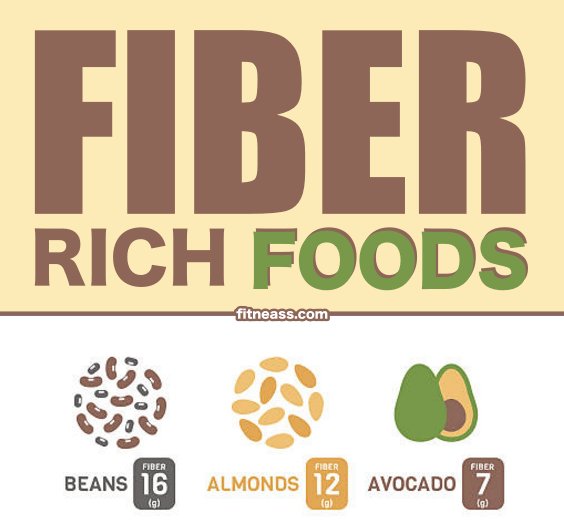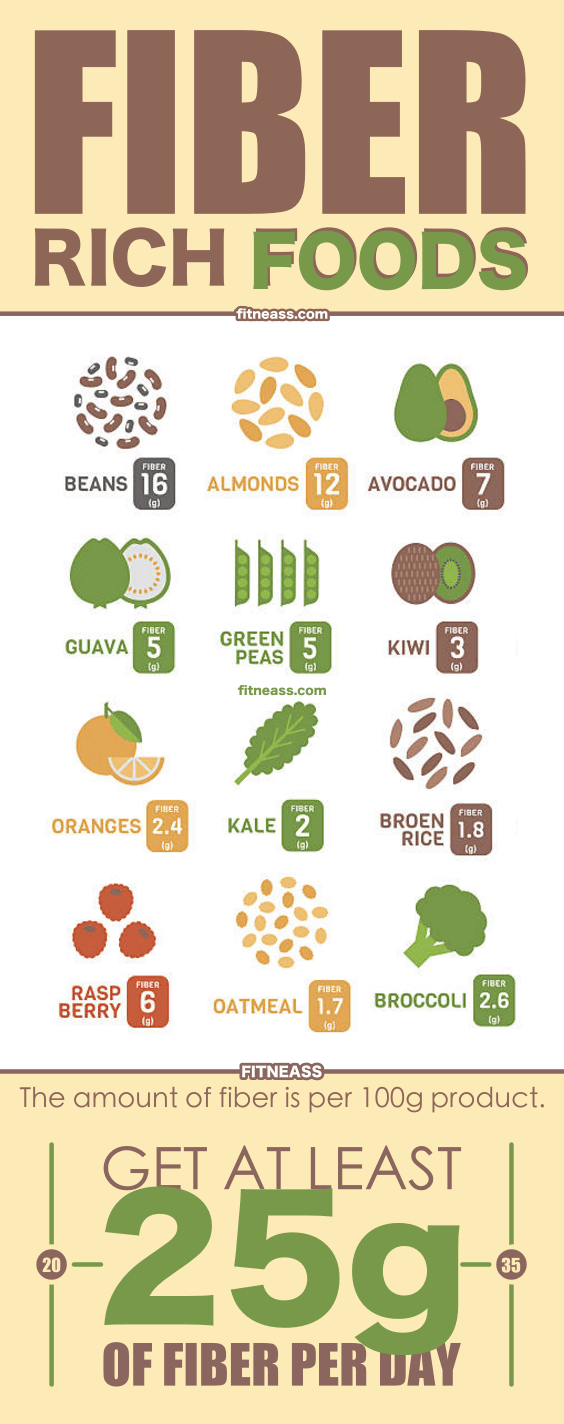12 Simple Ways You Can Add More Fiber To Your Daily Meals

Do you get your recommended daily amount of fiber? If not, then how do you add more fiber into your diet? What foods are rich in fiber? To find the best answers to these questions, continue to read.
What Is Fiber?
Dietary fiber is a plant-based nutrient which is sometimes referred to as rough age or bulk. It is a kind of carbohydrate but, unlike the other carbs, it is unable to be broken down into digestible sugar molecules. Therefore, it passes through the intestinal tract relatively intact.
However, as it goes on its journey, it does a lot of work.
The term “dietary fiber” simply means the indigestible parts of plant-based foods. In other contexts, “fiber” may be referred to as plant-based cloth, but when it comes to nutrition, the terms “fiber” and “dietary fiber” are often interchangeable.
Fiber RDA
The Institute of Medicine has set the recommended daily amount (RDA) for fiber intake for everybody.
Men who are 50 and younger should consume 38 grams of fiber daily, while men who are 51 and older should consume 30 grams. Women aged 50 and younger should consume 25 grams of fiber daily, while women 51 and older should have 21 grams.
According to the institute, most Americans do not consume enough of it.
Types Of Fiber
Fiber can be placed into two categories: soluble and insoluble.
Soluble fiber, such as gum, pectin, and mucilage can dissolve in water, while insoluble fiber, such as hemicellulose, lignin and cellulose do not. While in the body, it turns to a gel-like substance. Insoluble fiber, on the other hand retains its shape while in the body.
Both soluble and insoluble fibers have important health benefits. Soluble fiber helps decrease blood glucose (blood sugar) levels and also helps lower blood cholesterol.
Insoluble fiber helps speed up the passage of food through the digestive system, helping to maintain regularity and prevent constipation. This type of fiber also increases fecal bulk, making stools easier to pass.
Almost all plant-based foods contain both soluble and insoluble fiber, but the amount each contains vary.
Health Benefits Of Fiber
Dietary fiber, like other nutrients, has its own benefit to the health and that is why it is important to get enough of it daily. Listed below are the importance of this vital nutrient:
1. Controls Blood Sugar
The Soluble type may help to slow down the body’s breakdown of carbohydrate and sugar absorption, thereby helping to control blood sugar.
2. Decreased Risk Of Stroke
Studies report that for every 7 grams more of fiber consumed on a daily basis, your risk of getting stroke is reduced by 7 percent.
3. Weight Loss And Management
Fiber is a popular word when it comes to losing weight or maintaining the present weight. This is because it increases fullness.
4. Heart Health
A link has been found between fiber intake and heart attack. Research also shows that individuals who consume a high-fiber diet have a 40 percent lower risk of heart disease than those who do not.
5. Skin Health
Fiber, especially psyllium husk, may help push yeast and fungus out of your body, thereby preventing them from being excreted through your skin where they could cause eczema, acne or rashes.
6. Irritable Bowel Syndrome
It may provide some relieve for people who have irritable bowel diseases as it is linked to digestion.
7. Haemorrhoids
Daily consumption of a high fiber diet may help you lower the risk of haemorrhoids.
8. Gallstones And Kidney Stones
Daily consumption of a diet that is high in fiber can help reduce the risk of gallstones and kidney stones, this is likely due to the fact that it helps regulate blood sugar.
9. Diverticulitis
Insoluble fiber most especially may help reduce the risk of diverticulitis, which is an inflammation of polyps in your intestines. It reduces the risk by 40 percent.
How To Add More Fiber Into Your Diet?
Now that you already know why fiber is important, you need a guide on how to add more fiber in your diet. Follow these tips to get the adequate amount you need:
1. Choose A Wide Variety
Plant foods provide both the soluble and insoluble types. The soluble type increase fullness and the insoluble type promotes digestion.
Oats, peas, beans and fruits are great sources of soluble fiber and you can get insoluble fiber from whole grains and vegetables. You can get both from some foods.
2. Go For Whole Grains
Instead of refined carbohydrates, go for whole grains. They are a natural source of dietary fiber. In order to identify whole grains, check the labels and look for ingredients like; hard red winter wheat, whole wheat, oats, rye, barley, brown rice, millet, buckwheat, oatmeal, bulgur and triticale.
3. Start Your Day With A Fiber Boost
The most important meal of the day is breakfast and the meal must be nutritious. Go for a breakfast cereal with at least 3 grams per serving.
4. Eat High Fiber Snacks
When the time for snacks come, do not eat the high calorie, high fat and low fiber snacks, go for fiber rich snacks like granola bars, mixed nuts, whole grain crackers, dried apricots or figs and pop-corns.
5. Add Fresh Fruit To Your Meals
Consuming fresh fruits is a great way to add fiber to your diet, whether as a snack, added to your cereal or as a desert.
Fruits that are high in fiber include prunes, pears, orange, berries and apples.
6. Eat Kidney Beans Or Chickpeas
You can add more fiber to your diet by adding kidney beans or chickpeas to your salad. A quarter cup of this gives you 5 grams of fiber.
7. Snack On Pears
If you feel like snacking, eat pear. Just one pear gives you 5 grams of fiber. Snack on these delicious fruits out-of-hand, add them onto an almond-butter sandwich or simply blend them into a smoothie.
8. Raspberries
All those tiny seeds dotting raspberries are to be held responsible for raspberries’ high fiber content. Just one cup of these low-calorie berries supplies you with 8 grams of fiber.
Add more fiber to your meals by enjoying some berries with yogurt for breakfast, snack or dessert.
9. Oatmeal For Breakfast
Eating oats are a very great way to get soluble fiber, which helps to lower your cholesterol level. Begin your day with a cup of cooked oatmeal and you’ll supply your body with 4 grams of fiber.
Enjoy your oatmeal with a sliced banana or better still, add the banana while you’re cooking the oatmeal. This will add to the oatmeal’s creaminess- for an extra 3 grams.
9. Spaghetti
Substituting regular white pasta with whole-wheat pasta will supply you with more than twice as much fiber, which is 6 grams in a cup.
Eating 100 percent whole-wheat pasta or bread is a very simple way to start adding more fiber and whole grains to your daily diet.
10. Almonds
An ounce of almonds-24 nuts supplies you 4 grams. Pair your almonds with an apple or pear for your morning snack and you’ll be getting almost half of your daily dose of this vital nutrient.
11. Eat Beans
From kidney beans to black beans, all beans contain fiber-soluble and insoluble. One cup of boiled black beans contains 15.0 grams of fiber, Lima beans contains 13.0 grams.
12. Bake Your Own Fiber Rich Goodies
Add a boost to the fiber content of your own baked goods by using whole wheat flour to replace the all-purpose white flour in recipes. Add oatmeal to cookies, or load homemade muffins with berries, raisins, or bananas.
Conclusion
Fiber is a very important nutrient you should take daily for your general well-being, weight loss and weight maintenance. The very best way to add more fiber to your meals is to eat a balance diet and make friends with fruits and vegetables.
Make sure you hydrate yourself.
As you add more fiber to your diet, you increase your intake of fluids as well. It pulls water into the intestines, so without adequate hydration, it can actually aggravate instead of alleviating constipation. So make sure you drink at least eight glasses of water every day.
